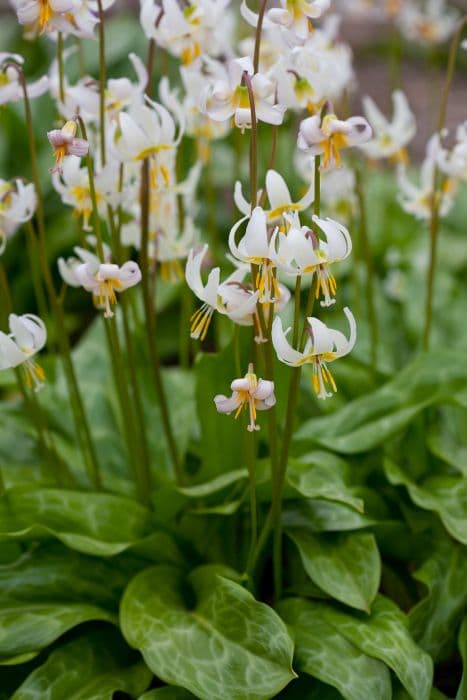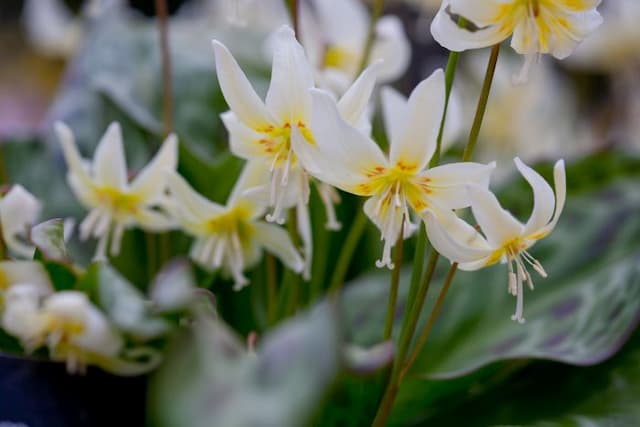Tulip 'Major' Tulipa orphanidea (Whittallii Group) 'Major' (15)

ABOUT
'Major' is a dwarf bulbous perennial, to 30cm tall, with lance-shaped grey-green leaves. Flowers are orange-red and yellow, with a black blotch, appearing in mid spring
About this plant
 Names
NamesFamily
Liliaceae
Synonyms
Whittall's Tulip, Orphanidea Tulip
Common names
Tulipa whittallii, Tulipa hageri, Tulipa lanata, Tulipa australis
 Characteristics
CharacteristicsLife cycle
Perennials
Foliage type
Deciduous
Color of leaves
Green
Flower color
Yellow
Height
0.5 feet (15 cm)
Spread
0.5 feet (15 cm)
Plant type
Bulb
Hardiness zones
7
Native area
Turkey
Benefits
 General Benefits
General Benefits- Aesthetic Appeal: Tulipa orphanidea 'Major', commonly known as Tulip, has vibrant orange and yellow flowers that can enhance the beauty of gardens and landscapes.
- Pollinator Attraction: The bright flowers attract bees and other pollinators, supporting local ecosystems.
- Seasonal Interest: Tulips mark the arrival of spring, offering an early burst of color after the winter months.
- Ease of Cultivation: Tulips, including this variety, are generally easy to grow and suitable for a variety of garden settings.
- Cultural Significance: Tulips have historical and cultural significance in many societies, often associated with festivals and celebrations.
- Hybrid Vigor: As a member of the Whittallii Group, 'Major' benefits from hybrid vigor, which can result in stronger, more robust plants.
- Versatility in Landscaping: Tulips can be planted in flower beds, borders, and containers, offering flexibility in garden design.
- Bulb Propagation: Tulips can propagate through their bulbs, making it possible to increase your collection or share with others.
 Medical Properties
Medical PropertiesThis plant is not used for medical purposes.
 Air-purifying Qualities
Air-purifying QualitiesThis plant is not specifically known for air purifying qualities.
 Other Uses
Other Uses- Tulipa orphanidea bulbs can be used as a source of starch in times of scarcity. The bulbs may be ground into a flour after thorough drying and processing.
- The plant's vibrant flowers are often used in fabric dyeing, providing a range of yellow to orange hues for textiles.
- Fine arts, specifically botanical illustration, can utilize Tulipa orphanidea as a subject due to its striking appearance and color.
- This tulip variety can be used in floral therapy practices for enhancing mood and creating visually stimulating arrangements.
- In landscape photography, Tulipa orphanidea serves as a focal point or an element of interest due to its distinctive shape and color.
- Educational purposes, such as teaching botany and plant reproduction, can be another use, thanks to its clear exhibition of flower parts.
- Culinary presentations may include Tulipa orphanidea petals as edible garnishes for salads and desserts, after ensuring they are free from pesticides.
- The petals might be used in craft projects, like in the making of handmade paper or eco-friendly confetti for events.
- During springtime festivals and parades, the flowers can be featured in floats and decorations to showcase seasonal blooms.
- Tulipa orphanidea can be integrated into wedding bouquets and ceremonies, especially for spring-themed nuptials, to add a splash of natural elegance.
Interesting Facts
 Feng Shui
Feng ShuiThe Tulip is not used in Feng Shui practice.
 Zodiac Sign Compitability
Zodiac Sign CompitabilityThe Tulip is not used in astrology practice.
 Plant Symbolism
Plant Symbolism- Perfect Love: The tulip, particularly red ones, symbolizes perfect, deep love, reflecting the idea of being truly and deeply in love.
- Rebirth: This flower is one of the first to bloom in the spring, representing rebirth and new beginnings, making it a fitting symbol for the start of new ventures or the renewal of promises.
- Royalty: Tulips are often associated with royalty due to their rich and varied colors as well as their upright posture, reflecting a regal bearing and wealth.
- Prosperity: Due to their historical value during the tulip mania in the Netherlands, they have come to represent abundance and prosperity.
- Fame: The flower’s dramatic and striking appearance can also symbolize fame or the desire for attention and accolades.
- Eternal Life: The tulip's perennial nature can symbolize immortality or the quest for eternal life.
- Forgiveness: The gentle and graceful form of tulips may represent forgiveness or an apology, suggesting a desire to repair relationships and convey regret.
 Water
WaterTulip 'Major' should be watered deeply when the soil feels dry to the touch, usually around once a week depending on the climate and weather conditions. It's essential to avoid overwatering as tulips prefer well-draining soil and excess moisture can lead to bulb rot. During the active growing season, typically in the spring, these tulips may need approximately 1 gallon of water per square foot every week. Ensure the soil around the bulbs gets soaked, allowing the moisture to reach the roots. Cut back on watering once the flowering period is over to prevent waterlogging as the foliage starts to die back.
 Light
LightTulip 'Major' flourishes best in full sunlight, ideally receiving at least 6 to 8 hours of direct sun daily. A spot that's exposed to early morning sun is preferable as it dries the dew quickly, helping to prevent fungal diseases. Take care to avoid overly shady areas, as insufficient light can lead to weak, spindly growth and reduced flowering.
 Temperature
TemperatureTulip 'Major' is hardy and can survive winter temperatures as low as 20°F; however, they prefer the cool spring weather, with the ideal growing temperatures ranging between 60°F and 70°F during the day and cooler overnight temperatures. These tulips can tolerate short periods of warmer weather, but prolonged heat can stress the plants and diminish their vigor and bloom periods.
 Pruning
PruningFor Tulip 'Major', pruning is minimal and typically involves deadheading the spent flowers to direct energy away from seed production and back into the bulb. After flowering, remove the flower heads but leave the foliage until it naturally dies back, usually by early summer. This allows the plant to photosynthesize and store energy for the next growing season.
 Cleaning
CleaningAs needed
 Soil
SoilTulip 'Major' thrives in well-draining, sandy or loamy soil with a pH between 6.0 and 7.0. For best performance, incorporate compost or well-rotted manure into the planting mix.
 Repotting
RepottingTulip 'Major' bulbs do not require frequent repotting and are typically replanted every few years or when the bulbs overcrowd.
 Humidity & Misting
Humidity & MistingTulip 'Major' tolerates average outdoor humidity levels. Maintain natural ambient humidity; no special humidity adjustments are necessary.
 Suitable locations
Suitable locationsIndoor
Ensure cold dormancy period & place in bright, indirect light.
Outdoor
Plant bulbs in fall, full sun to partial shade, well-drained soil.
Hardiness zone
3-8 USDA.
 Life cycle
Life cycleTulipa orphanidea 'Major', commonly known as Tulip 'Major', starts its life as a bulb which remains dormant underground during summer. In autumn, roots start to sprout from the bulb as temperatures cool, absorbing nutrients from the soil. The plant begins to grow in early spring, with shoots emerging from the bulb, leading to the development of stems and leaves. The tulip 'Major' then flowers, showcasing its characteristic vibrant blooms, which generally occurs from April to May. After the flowering stage, the plant sets seed, which can be dispersed to give rise to new plants. Finally, the foliage dies back after flowering, and the bulb goes into dormancy again until the next growth cycle begins in autumn.
 Propogation
PropogationPropogation time
Spring
Tulipa orphanidea (Whittallii Group) 'Major', commonly known as tulips, are typically propagated through division of their bulbs. The ideal time to propagate tulips by bulb division is in the fall, when the plant is dormant. To propagate, carefully unearth the bulbs after the foliage has died back and gently separate any small offset bulbs from the main bulb. These offsets, or bulblets, can be replanted immediately in well-draining soil at a depth of about 6 to 8 inches (15 to 20 centimeters) and spaced 4 to 6 inches (10 to 15 centimeters) apart. This method is popular as it not only propagates the tulips but also helps to rejuvenate crowded clumps, ensuring the continued health and bloom of these beloved spring flowers.









